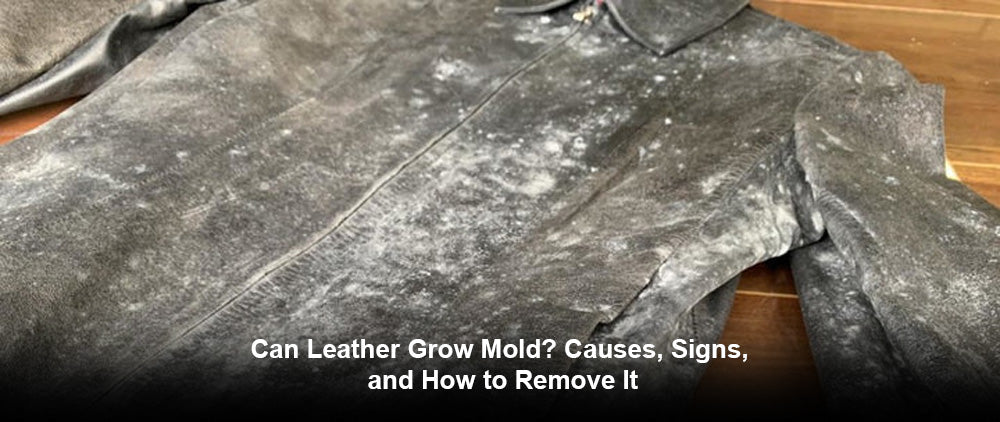Yes. Mold can certainly grow on leather. Besides, if you are a rider and constantly wear leather gear, you must know the health issues associated with it.
Leather has properties that are prone to moisture retention. With this, it can affect your health because moisture turns into mold quickly.
This can happen for various reasons: whether you live in a humid area, or the leather jackets or bags you own are poorly maintained.
Remember that if left untreated, mould can degrade your leather's quality and reduce its durability.
This guide is to help you get a detailed answer to “Can leather grow mold?”.
It will also ensure you learn the science behind the mold on leather jackets and help you point out the signs so you can prevent or restore them on time.
Whether you're an experienced rider or have been wearing a leather motorcycle jacket for ages, this information is to help you fight and stay safe from the mold on your leather gear.
Why Does Leather Get Moldy?
Leather, particularly genuine and full-grain kinds, is an absorbent material. Unlike synthetic fabrics, it "breathes" or absorbs moisture from its surroundings. When the humidity is too high or the leather item is not properly stored, mold spores in the air may stick to the surface and begin to grow.
What Causes Mold on Leather
- High humidity and inadequate ventilation: Leather gear stored in a damp garage or unventilated closet is especially susceptible to mildew.
- Storing damp items: Wearing your clothing in the rain and then storing it without first drying it is a surefire way to promote fungal growth.
- Lack of washing or conditioning: Dirt and body oils provide sustenance for mold. Spores flourish when routine cleaning is not performed.
Whether mold is found on leather jackets or motorcycle gear, the underlying reasons are virtually always environmental, combined with negligence.
Common Signs of Mold on Leather
Does leather mold get recognized? If you can catch the signs of mold early, it can save your leather gear from any kind of permanent damage. So, what to look for? Here are the signs you need to know:
- White, greenish, or black fuzzy patches that appear on the surface.
- A distinct musty smell, especially when the item is stored in closed spaces.
- Discoloration and a slimy or powdery texture indicate fungal growth.
Sometimes, the mold is invisible, so how do you know it's there?
Detecting invisible mold necessitates sensitivity to strange scents, surface changes, and understanding of the environment in which mold grows.
Furthermore, mold on a leather bag or jacket is often difficult to detect with the naked eye.
This is because it frequently starts to spread in the substance and goes undetected for a long period. However, certain warning indications should be taken seriously. The following advice and strategies can help you detect invisible mildew on leather:
- Odor: Mold on leather shoes or jackets, or bags frequently emits a musty or disagreeable stench, so if you notice a weird, musty odor, you need to get rid of leather jacket odors with simple methods.
- Moisture: If the leather has been stored in a humid environment or you discover evidence of moisture, there is a chance that invisible mold exists.
- Discoloration: Invisible mold can cause discoloration on leather surfaces. These are easy to ignore, especially if the leather has a natural pattern or color.
- Feel: Run your fingers lightly over the leather. If you notice any strange bumps or soft patches, this could suggest that mold is damaging the material from within.
Mold vs. Mildew: What's the Difference?
Mildew is typically lighter in color (white or grey) and lingers on the surface. Mold might be darker (green or black) and penetrate further into the leather. Both are undesirable, but mould is more aggressive and damaging.
If you find mold on your leather jacket, take action right away to prevent further degradation.
Even better, buy only high-quality, mold-resistant jackets. Need some? Explore durable men’s leather motorcycle jackets designed for durability and breathability.
How to Remove Mold from Leather Safely (Step-by-Step)
So, can you get mold off of leather? Yes. But, before you grab for bleach. Just Don’t.
Remember that leather isn’t your traditional clothing. It needs special maintenance. Just follow the steps below:
Preparation:
- To avoid breathing spores, wear gloves and a mask.
- Collect soft brushes, white vinegar, rubbing alcohol, clean rags, and leather conditioner.
Step-By-Step Process: Cleaning Mold Off Leather
1. Take the item outdoors
Avoid spreading spores indoors. If feasible, work in direct sunshine, but do not expose the leather to severe UV for an extended period of time.
2. Dry brush and vacuum the mold
Use a soft-bristled brush to release the mold. Vacuum gently with a HEPA-filtered cleaner.
3. Clean using a vinegar-water or rubbing alcohol solution
Combine water and white vinegar (or 70% rubbing alcohol). Wipe the leather with a lightly dampened cloth, being careful not to saturate it.
4. Soften your leather gear after treatment
After it has dried, apply one of the top leather conditioners for protection and to replenish oils lost during cleaning.
5. Dry in shade (never sun)
Allow the gear to dry naturally in a shaded, well-ventilated place.
Preventing Mold on Leather
But before you catch and clean the mold, maybe you can avoid it altogether. So, whether it's a motorcycle chaps collection or jackets in your wardrobe, you can keep a check and prevent mold.
The one tip to remember is cleaning a leather jacket the right way. Yes, when you clean right away, you can avoid any dirt or moisture from turning into mold.
How to Prevent Mold on Leather:
- Store in dry, ventilated areas. Never wrap leather goods in plastic. Choose cotton bags or breathable clothes wraps.
- Use dehumidifiers or silica gel packs. Perfect for closets and gear lockers.
- Clean and condition on a regular basis. At least once a month during peak usage seasons.
- Never store wet leather gear. Always air-dry first.
Can Mold-Damaged Leather Be Saved?
The answer depends on the severity. If it's surface-level mold, you can most likely restore it using the methods described above. However, if mold infiltrates the leather strands, the structure may disintegrate.
- Clean if the mold is new or is just on the surface level.
- If the leather smells bad after washing, feels brittle, or is weak, replace it.
How To Keep Leather From Molding: Best Practices for Leather Gear Maintenance
Routine care is more than simply keeping your leather gear looking good; it's also an important line of defense against leather jacket mold, mold on motorcycle gear, and general deterioration.
Mold flourishes in neglected environments, particularly where perspiration, humidity, and grime go unchecked.
With regular maintenance, you can not only avoid mold growth but also maintain the appearance, feel, and longevity of your investment.
Here’s what expert maintenance looks like:
- Weekly Dusting: Use a dry, lint-free microfiber towel to wipe off your leather goods. This removes surface debris, dust, and moisture, which can provide an excellent environment for mold growth on leather jackets.
- Monthly Conditioning: Use a pH-balanced, leather-safe conditioner to replenish lost oils and maintain the material's inherent elasticity. Conditioning minimizes cracking, which can trap moisture and provide breeding grounds for mold.
- Air-Drying After Use: Allow your gear to air dry completely after each use, especially if you've been riding in the rain or sweating. It's best to carry a rain suit.
Tip: Never keep moist leather; it is one of the quickest ways to attract mildew into motorcycle gear. Hang objects in a well-ventilated place before keeping them.
Why Investing in High-Quality Leather Matters
You probably know the answer to: Can leather grow mold?
Of course. But the quality of the leather you chose determines how fragile it is.
Due to improved tanning and finishing procedures, premium leather, such as the sort Daniel Smart produces, is naturally more moisture resistant. You can even recognize real leather by its smell. It usually has a natural, organic skin scent.
Its denser grain reduces water absorption, making it more difficult for mold to enter and spread.
Low-grade leather, on the other hand, is more porous, absorbs moisture rapidly, and cracks easily, making it perfect for leather jacket mold and motorcycle gear mold.
High-quality leather also has stronger stitching and fewer seams, which reduces the number of concealed areas where moisture might accumulate.
However, leather is still resistant to it, so it is better to get rain suits. Don’t know where to get? Shop protective men’s rain suits with Daniel Smart MFG.
For riders who value style and durability, investing in the correct gear from the start is wise.
Conclusion
Mold on leather isn’t just unsightly—it can be harmful to both your health and your gear’s longevity. Whether you're a seasoned rider or just love your leather apparel, understanding how mold forms and how to prevent it is essential.
Regular cleaning, proper storage, and conditioning are your best defenses. When mold appears, act fast with the right cleaning techniques. And remember, investing in high-quality, mold-resistant leather gear—like that from Daniel Smart—can make all the difference. Give your leather the care it deserves to keep it looking sharp and lasting longer. Stay safe, ride smart, and stay mold-free.
FAQs:
Q: Can leather grow mold?
Yes. Leather is a natural material that can develop mold when exposed to dampness and inadequate airflow.
Q: What causes mold to form on leather?
High humidity, moist gear storage, and a lack of annual maintenance are all common culprits.
Q: Is mold on leather dangerous to health?
Yes. Mold spores can cause allergic reactions, breathing problems, or skin irritation..
Q: How do you remove mold from leather safely?
Use a vinegar-water solution or rubbing alcohol, then condition and dry in the shade.
Q: How can I prevent mold on leather items?
Keep in dry areas, use dehumidifiers, clean frequently, and never keep wet gear.


